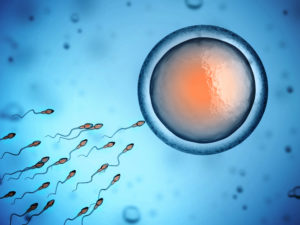
These super swimmers have an Olympics of their own to compete in.
Image: Shutterstock
Now that the Olympics are over and the medals have been awarded, let’s turn our attention from famous and infamous swimmers (Ryan Lochte) to a different bunch of super swimmers—yours! When it comes to reproduction, the competition is way more intense than at Rio. In fact, of the 1,500 sperm a second that are produced, only one will get the gold—the egg. And there is no silver or bronze on that podium! So let’s take an “up close and personal” look at the making of a champion!
Farm team
The testicles are where the sperm grow and form. They are completely filled with extremely thin, long, coiled up tubes like hollow spaghetti with special cells that support the forming sperm like soil supports a sprouting seed. If stretched end to end, the length of these tiny tubules is about 300 meters. It takes about two months for a sperm to go from its very beginning form to a mature sperm with a tail. This growth and development relies on two key hormones. One is called Follicle Stimulating Hormone (FSH), which is pumped out by the pituitary gland, a pea-sized gland that sits between the eyes behind the top of the nose. The other is testosterone, which is made by leydig cells, which are scattered between the tiny tubes.
The result is the little swimmers we know as sperm. Each sperm is about 1/20th of a millimeter long and about as narrow as a red blood cell. It has a head that contains the nucleus, and a neck connects the head to the tail, which is in charge of motoring the sperm toward the egg it hopes to fertilize.
Swim Lessons
Once the sperm have fully formed, they have actually split twice so that one cell becomes 4 sperm with tails. These “mature” sperm then are released and float along until they exit the tesicle into a special, larger tube called the epididymis. The epididymis is another really long, twisty-turny tube where swim lessons take place. This structure is about an inch and a half long, but if the tube were stretched out, it would be about 20 meters long! Over the next two weeks after the sperm arrive, they learn to swim.
This process is ongoing and continuous from puberty to the end of a man’s life.
Race Day
Once the sperm have become expert swimmers, they wait about a month for their Olympics. If they don’t get a chance to fertilize an egg in that time, they die off and dissolve.
On race day—that is, when a man ejaculates—the sperm are dumped into a much larger tube surrounded by muscle called the vas deferens. The sperm is squeezed up this tube by the muscular contractions until they reach the urethra inside the prostate, which is like a tunnel between the bladder and the urethra of the penis.
The prostate expels some fluid from its walls into the tunnel to make some of the semen, but the majority of the semen fluid is secreted from the seminal vesicles—two sacs that attach to the tunnel, each about an inch or two long. The seminal vesicles also provide the sugar that the sperm need to power up. Ultimately, semen is made up of 80% fluid from the seminal vesicles, 10% fluid from the vas deferens, and 10% from the prostate.
At the same time the sperm and other semen fluids enter the prostate tunnel, the bladder closes so the fluids of the semen don’t go in there. Muscles at the base of the penis start pumping the semen out through the urethra and out the tip of the penis. If the sperm are lucky that day, they’re pumped into the vagina. Once in the vagina the sperm must swim along the walls and make it past the cervix to find the egg and fertilize it. The sperm don’t know where the finish line is, and only one will cross it. They can “tread water” for many days as they look for the egg or wait for the egg to drop down.
So much for the basics. Now here are some interesting tidbits about those sperm that you may not know:
- 90% of ejaculated sperm is deformed. We’re talking two heads, two tails, pin heads, coiled tails, etc. While these deformities may affect a sperm’s ability to make it to the egg, they don’t necessarily mean that the man is infertile.
- Sperm need to stay cool. They’re about 4 degrees Fahrenheit cooler than the rest of the body. Muscles in the scrotum raise and lower the testicles to keep them at the best distance from the body for the best temperature.
- Not all sperm are “male.” In terms of chromosomes, sperm can be either “male” or “female”—in other words, some carry an X chromosome (female) and others carry a Y chromosome (male). Female sperm tends to be stronger than male sperm, which means it’s more likely that a female sperm will make it to fertilization. If a dad provides an X chromosome, the resulting baby will be female. If he supplies a Y chromosome, the baby will be male.
- No second testicle? No problem. Having only one testicle doesn’t necessarily mean you’re infertile. According to the Mayo Clinic, a single testicle can take over the entirety of sperm production.
Sperm are quite amazing, and there are many factors which can influence their production. A healthy diet filled with fresh fruits and vegetables and light on simple sugars or animal products is the best way to keep these swimmers in the fast lane.
